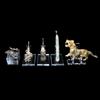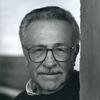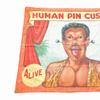BERRY CAMPBELL PRESENTS RAYMOND HENDLER: RAYMOND BY RAYMOND (PAINTINGS 1957-1967)
- NEW YORK, New York
- /
- June 29, 2021
PRESS RELEASE
FOR IMMEDIATE RELEASE
BERRY CAMPBELL PRESENTS RAYMOND HENDLER: RAYMOND BY RAYMOND (PAINTINGS 1957-1967)
NEW YORK, NEW YORK, June 29, 2021—Berry Campbell is pleased to announce its fourth exhibition of paintings by Raymond Hendler (1923-1998). Raymond Hendler: Raymond by Raymond (Paintings 1957-1967) features paintings created between 1957 and 1967, a transitional period for Hendler in which the artist moved away from an Abstract Expressionist mode and employed a more stylized line, producing distinct shapes and symbols. The exhibition is accompanied by a 16-page catalogue with an essay written by Phyllis Braff. Raymond Hendler: Raymond by Raymond (Paintings 1957-1967) opens July 8, 2021 and continues through August 20, 2021. Gallery summer hours are Monday - Friday, 10 am - 6 pm.
ABOUT THE ARTIST
A first-generation action painter, Raymond Hendler started his career as an Abstract Expressionist in Paris as early as 1949. In the years that followed, he played a significant role in the movement, both in New York, where he was the youngest voting member of the New York Artist’s Club. Hendler became a friend of Franz Kline, Willem de Kooning, Jackson Pollock, and Harold Rosenberg in Philadelphia, where he ran an avant-garde gallery between 1952 and 1954.
Raymond Hendler was born in Philadelphia, Pennsylvania in 1923 and studied in his native Philadelphia, at the Graphic Sketch Club, the Philadelphia College of Art, the Pennsylvania Academy of Art, and the Tyler School of Art (Temple University). In 1949, he continued his art training in Paris at the Académie de la Grande Chaumière on the G.I. Bill. Immersing himself in the Left Bank art scene, he formed close friendships with the Canadian Taschist painter, Jean Paul Riopelle, and the noted Australian sculptor, Robert Klippel. In Paris, he exhibited at the Musée d’Art Moderne and was a founding member of Galerie Huit, the first American cooperative gallery in Europe. Its members included Sam Francis, Al Held, Shirley Jaffe, Jules Olitski, among others.
Returning to New York in 1951, Hendler became part of the exploding Greenwich Village art scene. He was a voting member of the New York Artist’s Club from 1951 until its end in 1957. He was a friend of the leading figures in the New York School, including the painters Pollock, de Kooning, and Philip Guston and the critic Harold Rosenberg. With Franz Kline, he established a friendship that would last throughout the rest of Kline’s life. During this same period, Hendler was active in Philadelphia. At the Hendler Galleries, which he ran from 1952 to 1954, he exhibited the work of de Kooning, Sam Francis, Guston, Kline, George McNeil, Stephen Pace, Pollock, Milton Resnik, Riopelle, Ludwig Sander, and Jack Tworkov.
Hendler differed from Rosenberg’s belief that American post-war painting should have a clear break from the past. His work often recalls the autonomism and nonobjectivism of his European predecessors. However, Stuart Preston noted in The New York Times that Hendler had a “totally different approach to nonobjectivism….He excels in bright hard explicit pattern-making, in straightforward parades of independent shapes, not unlike those in Matisse’s collages. There is something reminding of Leger here as well, particularly in the unambiguous glare of contrasted color and in the robust refusal to allow shapes to suggest anything beyond their merry self.” [1] Hendler was represented by Rose Fried Gallery, one of the most important galleries of its time and a champion of many European artists: Marcel Duchamp, Juan Gris, Vasily Kandinsky, Joan Miro, and Piet Modrian. His work was a superb addition to the gallery’s roster.
Although images are at times visible, Hendler always maintained that his work was non-representational. Instead, the images serve to convey his vitality and child-like sense of wonder in a highly sophisticated order. In a review for The New York Times, Helen Harrison writes that the “schematic character…exploits the crispness of acrylic without sacrificing painterly energy.” [2] Jane Gollin said, “his cheerful style never succumbs to mere visual intoxication…traffic is patiently, wittily controlled in paintings that are simultaneously cerebral and sensuous.” [3] The artist called these artistic scrawls “graffiti” before the style became popular as an art form. Hendler continues, “Writing is a kind of self-revelation that gives you a chance to become. It acts as a catalyst. It does all a line can do in terms of noting and connoting.” [4] Remarking on Hendler’s departure from the popular Abstract Expressionist style, Kline wrote: “The direct austere design and color complexes paint the image without undue nuances—with clarity and mature independence.” [5]
Hendler had frequent solo and group exhibitions in New York, Philadelphia, Minneapolis, and other locations. He was represented by the Rose Fried Gallery during the 1960s and had a series of solo exhibitions until Fried’s death in 1970. In 1963, he received the Longview Foundation Purchase Award, juried by de Kooning, Thomas Hess, Guston, Rosenberg, and David Smith. Since Hendler’s death in 1998, his work has continued to be featured in solo and group shows, many of which are important reconsiderations of the art of the second half of the twentieth century.
During his forty-year teaching career, Hendler also taught at the Contemporary School of Art, Brooklyn; Parsons School of Design, New York; Pratt Institute, Brooklyn; and School of Visual Art, New York; and Minneapolis College of Art, where he was head of the painting department. Hendler retired from teaching in 1984 and moved two years later to the East End of Long Island. He lived and painted for the last ten years of his life in the house in East Hampton’s Northwest Woods that he built with his wife, Mary Rood.
Hendler is represented in the collections of numerous museums and public collections in America and abroad, including Birla Academy of Art & Culture, Calcutta, India; Frederick R. Weisman Art Museum, Minneapolis; Grey Art Gallery, New York; J. Walter Thompson Company, New York; Minneapolis College of Art & Design; Minneapolis Institute of Art; New York University; Novartis Co., East Hanover, New Jersey; Philadelphia Museum of Art; Pennsylvania Academy of the Fine Arts, Philadelphia; University of New Mexico, Art Museum, Albuquerque; University of Notre Dame, Indiana; and Walker Art Center, Minneapolis.
[1] Stuart Preston, “Art: Abstractionist Seeks Nature’s Aid,” Arts Magazine, 1967.
[2] Helen Harrison, “Avant Garde,” The New York Times, October 22, 2000.
[3] Jane Gollin, “Art Review: Raymond Hendler,” Pictures on Exhibit, 1962
[4] Gordon Brown, “Interview with Raymond Hendler,” Arts Magazine, 1967.
[5] Franz Kline, Raymond Hendler (catalogue for an exhibition at Rose Fried Gallery), 1962.
ABOUT THE GALLERY
Christine Berry and Martha Campbell opened Berry Campbell Gallery in the heart of Chelsea on the ground floor in 2013. The gallery has a fine-tuned program representing artists of post-war American painting that have been overlooked or neglected, particularly women of Abstract Expressionism. Since its inception, the gallery has developed a strong emphasis in research to bring to light artists overlooked due to race, gender or geography. This unique perspective has been increasingly recognized by curators, collectors, and the press.
Berry and Campbell share a curatorial vision that continues with its contemporary program. Recently the Museum of Fine Arts, Houston acquired works by abstract painter, Jill Nathanson. Harry Cooper, senior curator and head of Modern art at the National Gallery of Art, Washington, D.C. chose a painting by Judith Godwin from the 1950s to hang in their Abstract Expressionist galleries. Works by Frank Wimberley were acquired by the Studio Museum in Harlem, New York and the Smithsonian Museum of American Art, Washington, D.C.
Berry Campbell has been included and reviewed in publications such as the Wall Street Journal, Artforum, Art & Antiques, The Brooklyn Rail, the Huffington Post, Hyperallergic, East Hampton Star, Artcritical, the New Criterion, the New York Times, Vogue, and Whitehot Magazine of Contemporary Art. In 2020, Roberta Smith reviewed Ida Kohlmeyer: Cloistered for the New York Times. This rare group of paintings from the artist’s estate had not been on view together since they were created in the late 1960s.
Not only has Berry Campbell's program expanded, but in 2015, the gallery physically expanded, doubling its size to 2,000 square feet. The gallery recently added the estates of Frederick J. Brown and Mary Dill Henry to its roster. Berry Campbell is located at 530 West 24th Street in the heart of Chelsea, New York, on the ground floor.
Contact:
Berry Campbell2129242178
info@berrycampbell.com
530 West 24th Street
New York, New York
info@berrycampbell.com
2129242178
http://BerryCampbell.com















